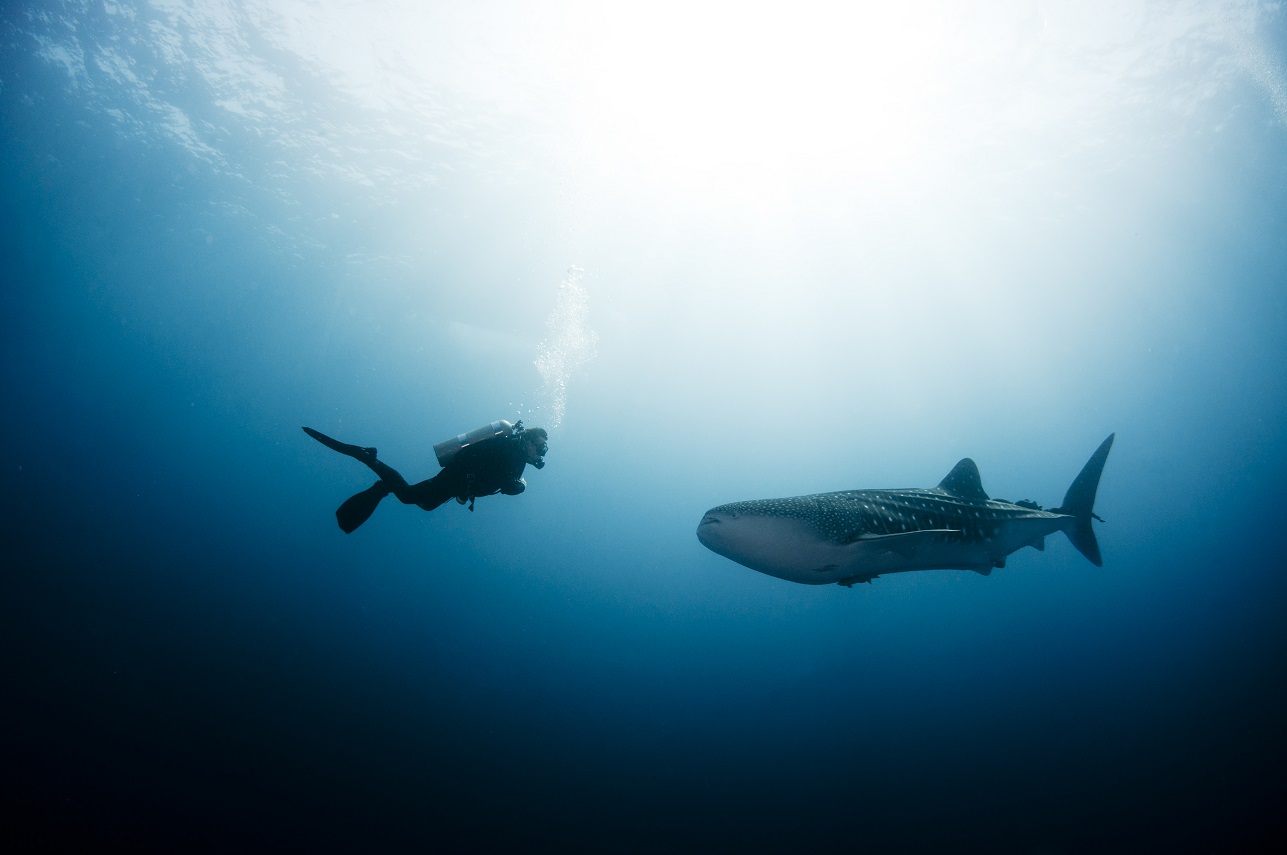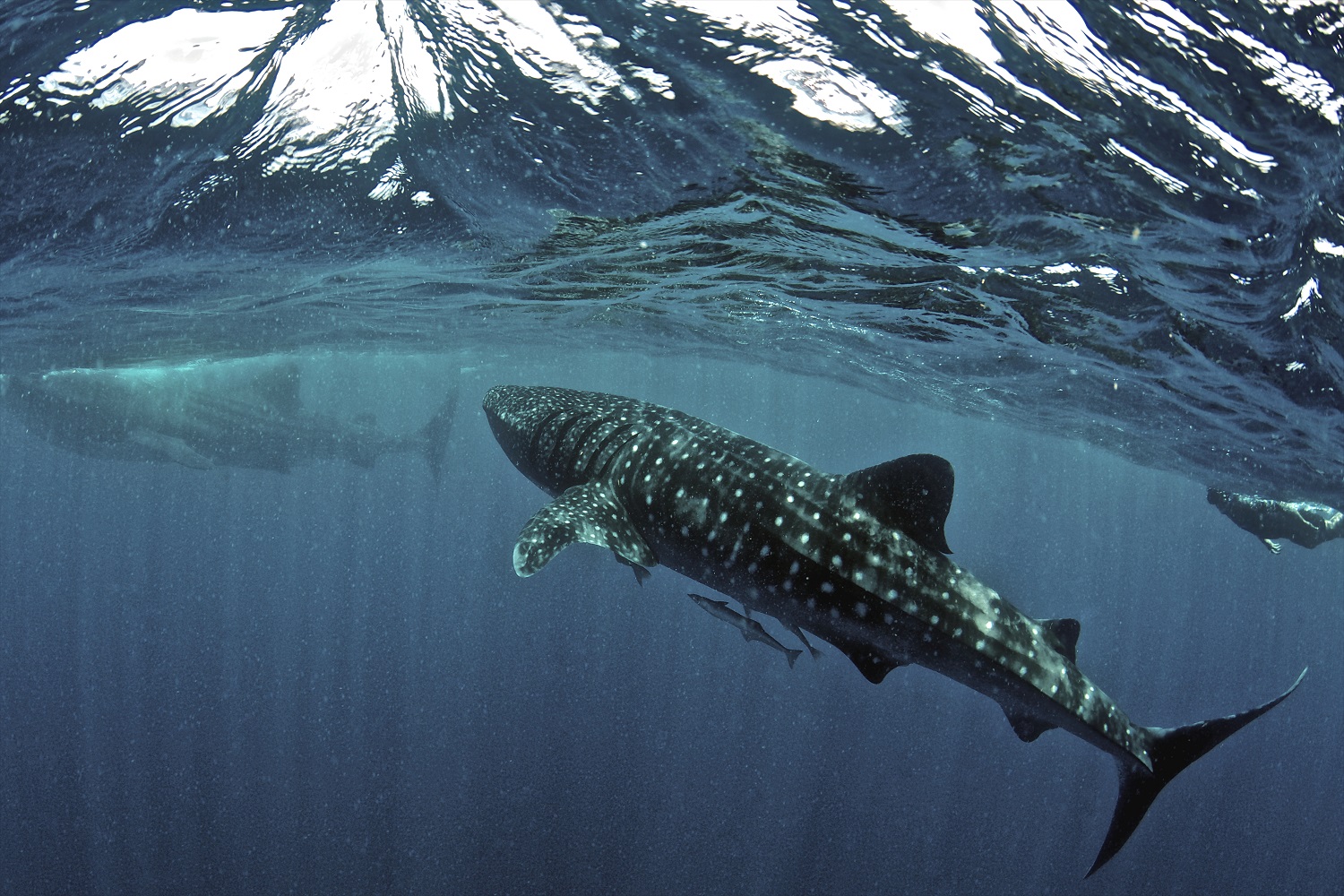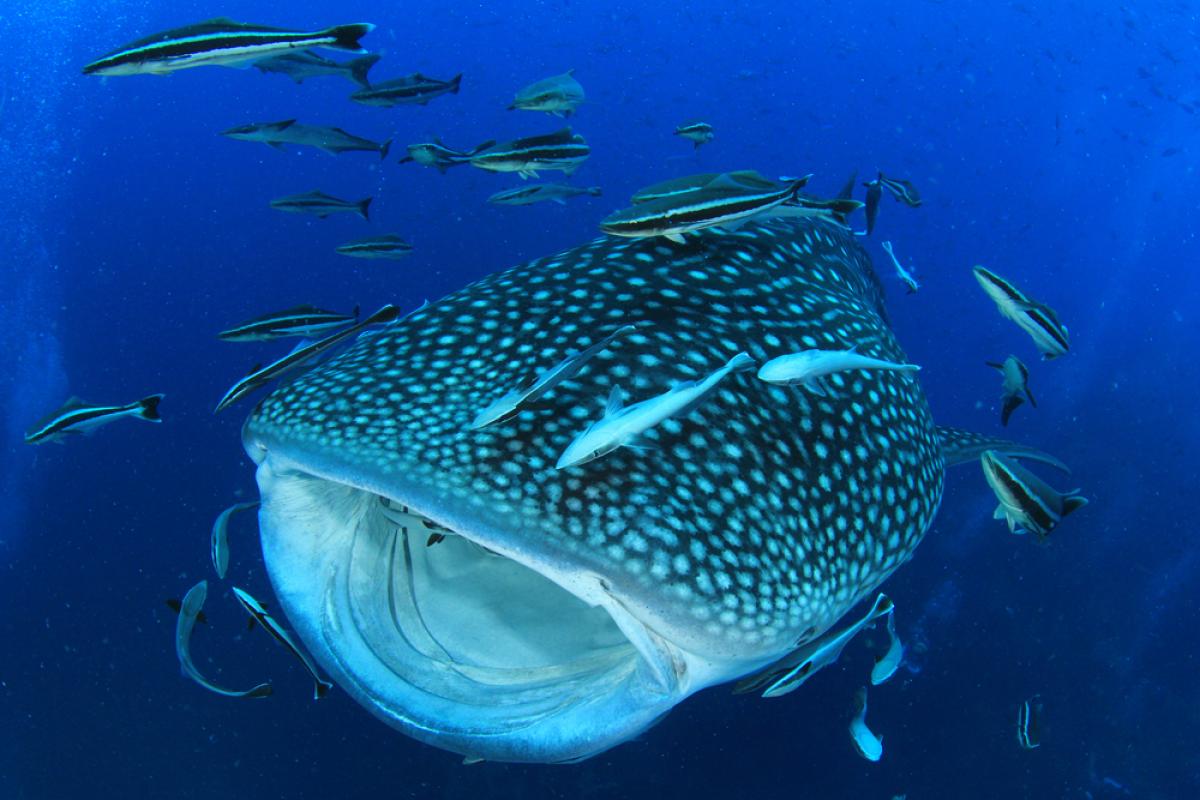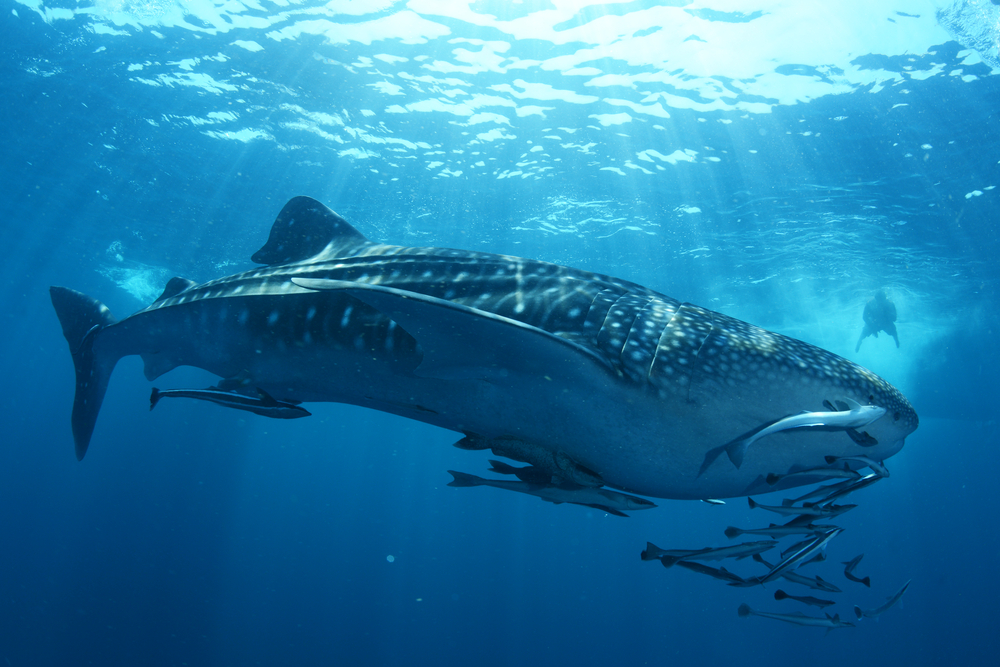Table of Content
Diving With Whale Sharks: Everything You Need to Know
Whale sharks are the biggest fish in the ocean. And you seriously won’t believe how big they are until you’re in the ocean right next to one!
Swimming with these polka dotty dudes is totally unforgettable. Whale sharks can grow up to a whopping 18 meters long – about the length of a school bus. They’re absolutely massive, weighing many thousands of kilos when fully grown!
But fear not, these humongous beings are nothing to be afraid of. They’re big friendly giants and the most docile of sharks. That’s why they’re on every scuba diver, freediver, and snorkelers’ bucket lists!
Whale sharks are one of the ocean’s greatest mysteries. They’re almost constantly on the move, and they spend a lot of their time at great depths (nearly 2km deep). So little is known about their life cycles and breeding habits. They can live to be over 100 years – which is no mean feat for an animal so large.
Whale sharks are migratory beings. They follow their food source around tropical and temperate waters throughout the world. As humans, we frequent our favourite restaurants. Whale sharks do the same, surfacing at biological buffets around the world to fill up on krill, fish spawn, shrimp, and plankton. Then they disappear into the deep again…
Whale sharks are filter feeders. They don’t use teeth to capture prey like most sharks. Rather, they scoop up masses of microscopic plankton into their meter-wide mouths. This is why you often find them at the surface of the ocean. This is why most whale shark interactions around the world are swimming or snorkelling, rather than scuba diving.

There are plenty of places you can scuba dive with them, though. What’s best? There are liveaboards all over the world where you can keep doing it, day after day! Most places you can swim with whale sharks are seasonal. But some lucky locations have whale sharks all year round due to plentiful plankton.
If you’re ready to frolic with these big fishies, then read on to hear all about their favourite places, and get ready to dive in! We’ll tell you all about where to swim with whale sharks.
Top 12 Best Places to Swim and Dive With Whale Sharks
Swimming With Whale Sharks in Mexico
Mexico is home to a couple of whale shark meccas. Firstly, there’s Socorro – nicknamed Mexico’s “Little Galapagos” due to its attraction of large pelagics and its unique ecosystem. It’s one of the top spots in Mexico to get cosy with whale sharks!
Hosting some of the world’s top dive sites comparable to other Pacific legends, Socorro is also one of the easiest places to access from the Americas and other parts of the world too.
Over in the Gulf of California AKA the Sea of Cortez – swimming with whale sharks is pretty much guaranteed from July to October. And it’s not only the big spotty fish you can see here! Cali sea lions, massive mantas and dolphins grace the waters too, so you’re in for a treat.
In the balmy waters off the Yucatan Peninsula, lies one of the most reliable places for whale shark encounters in the world. Get yourself on a 25-minute boat ride from the mainland between Isla Holbox and Isla Mujeres. There you’ll find aggregations of whale sharks in the hundreds!
Your best chances of seeing them are in August and September. Scuba with whale sharks is banned here, but your snorkelling experience will be epic. The whale sharks often sit vertically, with their mouths agape, feeding on thousands of plankton!
There are options to go on liveaboards in Mexico to chance swimming with whale sharks – what are you waiting for?
Dive type: Swimming with whale sharks
When to go: January – April

Diving With Whale Sharks in Belize
Get your moon charts at the ready. The whale shark aggregations on the Southern Barrier Reef in Belize are aligned with the spring lunar cycle. Your best chances of encounters are from April to June when mass Mutton and Cubera snapper spawning attracts heaps of big spotty fish.
In the few days before and after the full moon, they’re abundantly present to make the most of the biological buffet.
The best place to see them is from Gladden Spit and Silk Cayes Marine Reserve (GSSCMR) off the coast of Placencia.
There are stringent rules in place to protect the sharks here – which is usually a sign of great conservation efforts. Hopefully, this means that the whale sharks will be around the area for many years to come!
Divebooker have options to go on liveaboards to scuba dive with whale sharks in Belize and in the Caribbean.
Dive type: Scuba diving with whale sharks
When to go: April – June
Diving With Whale Sharks in the Philippines
The Philippines is famous for whale sharks for a reason! There are a couple of very well known sites around the islands.
Whale sharks were ‘discovered’ in Donsol back in 1998 and it has since become one of the nation’s main tourist destinations. The sharks come in close to the bay in search of plankton so you see them up close. You witness them in a comparatively natural environment compared with Oslob, Cebu. The swims here are reportedly more ethical too, as the sharks aren’t baited.
The peak season runs from February to April. Whale shark encounters are limited to snorkelling. But scuba divers can explore sites like Manta Bowl and Ticao Island too. The chances of stumbling across whale sharks underwater here is pretty high!
Palawan’s Honda Bay is another epic place to dive with whale sharks. Between dives, the boats scout for whale sharks. On custom trips, you can snorkel with them too. Some local fishermen will also take tourists out on their traditional outrigger bangkas for a more local experience!
Last but not least, Tubbataha Reef is one of the Philippine’s premier diving locations. Since 2015, more whale sharks have been congregating in the area, attracting liveaboards and becoming one of the hot spot destinations around the islands.
Hop on a liveaboard for your best chances of scuba diving and swimming with whale sharks in the Philippines.
Dive type: Scuba diving and swimming with whale sharks
When to go: November to June (Donsol), April to October (Honda Bay)

Diving With Whale Sharks in Honduras
Whale sharks circulate the waters of Utila, Honduras, all year round. The Roatan Aggressor visits this island for several days during its itinerary and offers an amazing way to explore the islands’ best dive sites and see whale sharks!
Whale sharks are most often spotted on impromptu snorkelling sessions between scuba dives.
It’s a hit or miss kind of place, but the stats are in your favour. Guides look for the key indicators of whale shark presence – jumping tuna and flocks of seabirds. This is the ‘whale shark capital of the Caribbean’! Local guides say you can even spot whale sharks from shore. If you’re wondering where to swim with whale sharks, Honduras could be it!
The big fishes are usually seen in the deep waters to the north of Utila. Utila Open Water is the site most famous for spotting them – where a large bank leads into the ocean blue!
Utila is home to one of the few year-round whale shark research centres. It’s a bit of a backpacker vibe – which is definitely worth knowing before you rock up expecting a chill time. Head there in March to April and August to September when the whale sharks are in their highest concentration.
Dive type: Scuba diving and swimming with whale sharks
When to go: All year round
Diving With Whale Sharks in The Galapagos
If you’re an ocean baby, then you’ll have heard of the Galapagos Islands. Located around 1,000km off the coast of mainland Ecuador, far into the Pacific Ocean. The oldest island in the archipelago is 3.5 million years old, while the newest islands are still being created.
The Galapagos is a place of wonder, on land and in the ocean. Three ocean currents converge here, bringing many nutrients to shallow waters. Between the three currents, one is always bringing whale shark snacks to scuba dive-able depths.
Darwin and Wolf Islands are the best places to chance an encounter. Although whale sharks are around all year, the dry season from June to December is the best time to go.
These islands are only accessible by liveaboard – they’re around a 12-hour overnight boat ride from the islands with airports! Better pack your sea-sickness tablets if you’re prone!
Dive type: Scuba diving with whale sharks
When to go: All year
Diving With Whale Sharks in Indonesia
Hit up the world-famous Cenderawasih Bay in the Northern Province of West Papua for an almost guaranteed swim with whale sharks. You can go snorkelling and scuba diving with whale sharks here.
The whale sharks here aren’t fed per se, but they’re attracted to the fishing nets of the traditional fishing platforms called ‘bagans’. They come up and suck on the bottom of fishing nets, in this beautiful little protected bay.
What’s awesome about this place is its biodiversity. It’s not just whale sharks you can swim with here. There are plenty of dolphins and rare little dugongs too. There are also four types of turtles – green sea turtles, hawksbill, Pacific Ridley and Leatherbacks! It’s not limited to the big stuff – there are also some legendary muck diving sites for macro galore scuba diving!
In Indonesia, Liveaboards are one of the best ways to see the remote islands and a great way to get super interactions with whale sharks.
Dive type: Scuba diving and swimming with whale sharks
When to go: May to September
Diving With Whale Sharks in the Maldives
The Marine Protected Area of South Ari Atoll is one of the most epic places in the world to swim with whale sharks. It’s one of the Maldives’ largest atolls, peppered with pinnacles where pelagic species meet. Juvenile whale sharks are spotted all year round at Maamigili Beyru, in the south of the atoll.
From Sun Island off the south shore, there’s a shallow plateau which makes it easy to spot whale sharks. Here, scuba divers and snorkelers can share the action with the big spotty fish!
Whale sharks are around all year in the Maldives and different Liveaboards visit various locations to align with their presence. The best time to visit the Central Atolls is from October – April, while Hanifaru Bay is at its peak from July – October. Liveaboards traverse the Deep South in January to March. From May to December, they’re found on the western side, when there’s also the best weather on land too. The most whale sharks are always recorded in the week building up to the full moon during these months. Then they head east until April. Hop on a liveaboard in the Maldives during the peak whale shark season for your best chances of encounters.
Use the local Maldives Whale Shark Research Programme’s Whale Shark Network Maldives app for up to date whale shark sightings.
Dive type: Scuba diving and swimming with whale sharks
When to go: Central Atolls, October – April; Hanifaru Bay, July – October; Deep South, Jan – March

Diving With Whale Sharks in Thailand
Thailand is home to some of the world’s most gorgeous marine life. From February through to April, set sail on a liveaboard in the Similan Islands to scuba dive with whale sharks and massive manta rays!
It’s not just whale sharks you can see on a liveaboard in Thailand, though! You may be lucky enough to see leopard sharks, whitetip reef sharks, nurses and silvertips. And that’s just the sharks. There are also turtles in the plenty, schooling fish and at some dive sites, it’s macro-mania!
Thailand is somewhat more touristy than other destinations, but it’s still a top spot for scuba diving with whale sharks. Liveaboards in Thailand offer a great opportunity to access more remote islands and scuba dive with whale sharks.
Dive type: Scuba diving with whale sharks
When to go: November to May
Swimming With Whale Sharks in Australia
The UNESCO World Heritage Site, the Ningaloo Reef, is home to a yearly aggregation of hundreds of whale sharks. During the coral spawnings in March and April each year, the whale sharks gather to feed on the rich supply of plankton and krill.
All tour operators follow the guidelines of Parks and Wildlife. This ensures the safety and conservation of whale sharks to the utmost standards.
Scuba diving isn’t permitted with whale sharks along the whole of the Ningaloo Reef. All tours are swimming with whale sharks. And the whale sharks here are usually on the go, so you’ll be swimming alongside them for as long as you can!
Local regulations state you must stay 3 meters from the body and 4 meters from the tail of whale sharks. But this isn’t that far when you realise you’re swimming next to thousands of kilos of fish!
Whale shark swim operators have planes up in the air, helping the boats to find whale sharks and have the best interactions. 97% of tours result in an encounter, and all operators offer a guaranteed sighting! So even if you don’t get lucky, you can come back for free and try again.
Liveaboards don’t operate in the area due to regulations. But there are plenty of opportunities to swim with whale sharks and go scuba diving and snorkelling on the Ningaloo Reef and the Murion Islands.
Dive type: Swimming with whale sharks (you really swim with whale sharks – not just have a lazy snorkel)!
When to go: March – July
Diving With Whale Sharks in Tanzania
While Whale sharks are usually migratory, in Tanzania, they hang around all year! Scientists say they never leave because of the abundance of delicious whale shark snacks which are permanently around.
Kilindini Harbour on Mafia Island is the place to be for whale shark spotting, as it’s still relatively unvisited.
Snorkel tours mostly run from the west side of the island, but it’s not forbidden to scuba dive outside of the marine park! So there’s a chance to dive with the big spotty fish in Tanzania, too.
It’s not uncommon to see groups of sharks during the peak periods, and it’s common to swim with many sharks on a tour! The time to swim with them is still seasonal even though they’re around all year. After the peak season from October to February, they dip down into deeper waters.
Dive type: Scuba diving and swimming with whale sharks
When to go: October to February
Diving With Whale Sharks in Mozambique
Cabo San Sebastian is home to one of the greatest gatherings of whale sharks in Africa. Juxtaposed with pristine coral reefs, and blessed with a lack of heavy tourism. This is one of the best off-the-beaten-track places to swim with whale sharks.
The whale sharks here tend to be on the larger side – averaging around 10 meters. It’s a place where you can definitely up your bragging rights with your buddies.
Tofu Beach is another amazing spot – and a scuba diver’s dream. Rivalling Cabo San Sebastian as a whale shark aggregation hotspot, it’s not uncommon to see shivers of 50 sharks or more!
Thank you, plankton, for being in a never-ending supply here!
Dive type: Scuba diving and swimming with whale sharks
When to go: November to February (Cabo San Sebastian), October to March (Tofu Beach)
Diving With Whale Sharks in Cocos Island
Cocos Island, Costa Rica, is one of the most famous scuba diving locations worldwide. In part, due to its remoteness and difficulty to get to – its unattainability makes it even more appealing to adventurers!
You can only access Cocos Island via diving liveaboards. Boarding at Puntarenas, Costa Rica, trips usually run for 8-10 days, and the island takes around 36 hours to get to! This is not a trip for the faint-hearted or seasick prone among us!
It’s hardcore Pacific conditions, with heavy currents and surge. Hence, it’s an advanced diving destination. The best time to go to see whale sharks (and manta rays!) is from June to November, during the wet season.
Dive type: Scuba diving with whale sharks
When to go: June – November
Get ready to swim with whale sharks on lush Liveaboards around the world
Prepare yourself to knock off another thing from your bucket list! Set sail on one of our liveaboards to go scuba diving and swimming with whale sharks. We’ve chosen the 11 top destinations around the world to hang out with the biggest fish there is. So, where are you going to go?!
Written by Natasha Allen
Tash is a Divemaster and ocean conservationist, currently based down under in Aussie. She’s chasing an endless summer while sharing the love of the underwater world.
When she’s not guiding people in the water, showing them epic marine life, she’s communicating about it as a freelance copywriter and social media manager.
In her spare time, you’ll catch her exploring, hiking, and riding horses. Or more likely down the pub or beach bar with mates